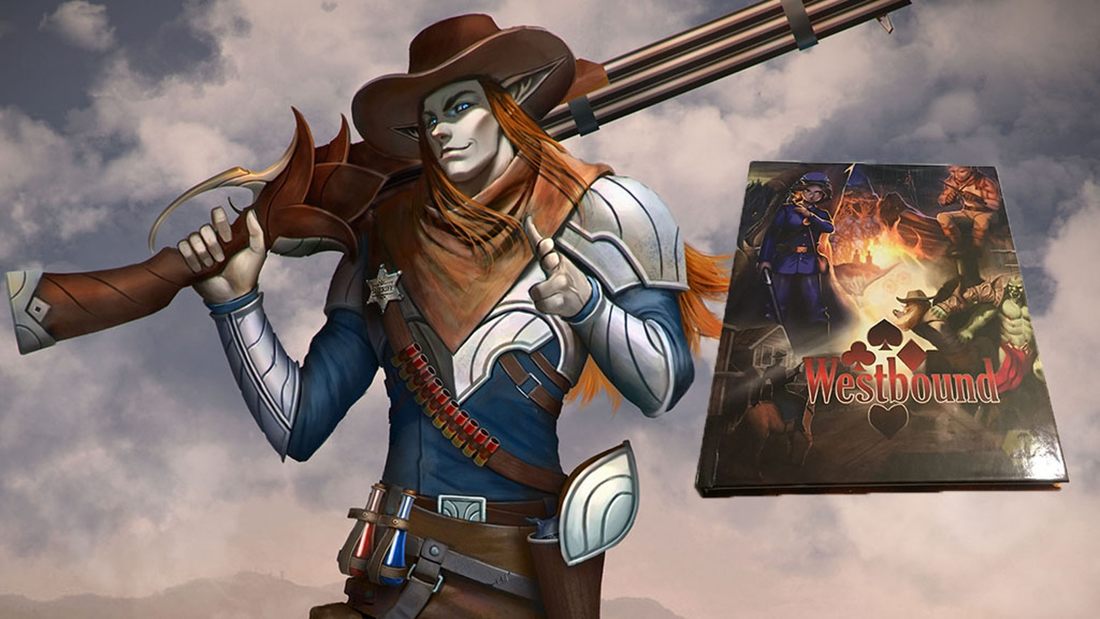 The Wild West is a unique genre of fiction. It has it’s larger-than-life characters and legends, including encounters with the other world, lawless lands where might makes right, and even tales of lost treasures! This genre has all the trappings that make for fantastic tales of adventure, so with that in mind, let’s take a look at Westbound, the tabletop RPG that blends The American Wild West with Fantasy! 1) Who Made This? Westbound is produced and published by the Canadian game company Island of Bees, and is currently their only released game. Nevertheless, they’ve put a great amount of effort into designing the game, and it shows: marvelous artwork, handy diagrams and charts, and even layout flourishes that compliment the Wild West theme. 2) What’s The Premise And Setting? If you’ve somehow managed to avoid watching any of the classic Clint Eastwood movies, or other flicks from the spaghetti-western genre, Westbound harkens to a romanticized era in North American history called “The Western Frontier.” This was an era when settlers from Europe expanding westward from the east coast of North America, into what would become the modern day nations of the United States of America, Canada, and Mexico. However, Island of Bees punches up the fantastical element. While the Western Frontier is already a very storied body of history full of tall tales and unbelievable legends, Westbound also includes contemporary fantasy tropes. Among them are parallel worlds, magical wands and musical instruments, and the classic fare of races including elves, dwarves, orcs, and goblins. One thing I find particularly interesting about Westbound is some of the more unusual inclusions. Ogres are included as a playable race, complete with their own variety of magic that revolves around eating themselves stupid. There’s also the inclusion of musical instruments as weapons; they may not physically harm enemies, but they can still cause a great enough amount of distress to rob enemies of the will to fight. (Meaning you can annoy somebody into submission with an accordian.) 3) What Are The Mechanics Like? Staying true to the western theme, Westbound forgoes using dice in favor of a standard deck of playing cards. (So if your GM or another player really ticks you off, you can switch to everybody’s favorite rage game of 52 Pick Up.) Outside of combat, drawing cards and comparing them to a target number is the method used for resolving checks. In combat though is where things get interesting. The game changes from simple draw and compare to a meta-game of managing a hand of cards for your offence and defence. The long and short of it is that you can either play cards from your hand to raise your ability to resist damage, play them against opponents to take them out of a fight, or burn through your cards to get to something more useful. To add an additional layer of strategy, though, each of the above combat actions functions a different way. Cards played to defend must be done in descending order, while cards played to attack must match the traditional sets from poker. (2 of a kind, full house, etc.) Character creation is composed of picking a Sort, Breed, and Archetype, which are similar to Class, Race, and Background in Dungeons and Dragons. Each one grants a different kinds of abilities, with Sort mostly pertaining to combat, Archetype focusing on social interactions, and Breed granting miscellaneous abilities. Additionally, whenever a character levels up, they pick which of the three aspects they wish to improve, giving some control to the player over what their character shapes into. 4) What Is It Similar To? As far as game mechanics go, Westbound’s use of a deck of cards is more than just a novelty. It grants some degree of certainty that a character will get an awesome moment, since used cards get discarded. It cuts both ways, though, since even those good draws will be discarded. The only other game I can think of that grants this much certainty over how much a character can truly accomplish is Golden Sky Stories, which completely eschews dice and randomness altogether! In regards to setting, I’d be inclined to say that Westbound is a graceful advancing of the Dungeons and Dragons time period. Even if you’re unfamiliar with the Western Frontier, there’s still plenty of contemporary fantasy elements to take hold of. This union of Wild West and Fantasy works really well together, because there was still lots of superstition that circulated in the 19th century to weave in magic. 5) Is It Worth Getting Into? Definitely. If you want to try something new, but don’t want to abandon fantasy, Westbound is a great choice. It offers a unique set of mechanics, and a setting that’s refreshing and familiar all at once. Plus, the artwork is fantastic, and featured in a few sets of special playing card. Useful for if you want to add more flair to your games of Westbound, or if you like the art, but maybe not the game. While Aaron der Schaedel is definitely enamored with Westbound, his favorite mix of wild west and fantasy remains the video game series Wild ARMs. You can inform Island of Bees of this treachery via Twitter @WestboundGame or tell Aaron his taste in video games is trash @Zamubei Picture Reference: https://www.kickstarter.com/projects/82773185/westbound-revolvers-and-rituals Leave a Reply. |
All blog materials created and developed by the staff here at High Level Games Archives
April 2023
Categories
All
|
Proudly powered by Weebly



 RSS Feed
RSS Feed